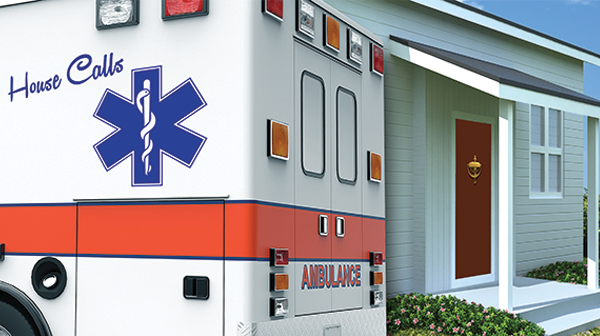
- “Mrs. A is back with her CHF. She was discharged yesterday, but she didn’t have a ride to go get her prescriptions filled.”
- “Mr. B is hearing voices again. They say it is cold outside, and he is hungry.”
- “Mrs. C is dying and with hospice. The family called her doctor when she started having trouble breathing, and the recording told them to call 911 if it was an emergency.”
- “Miss D is here because she wants to get off of drugs.”
- “Mr. E could go home, but he lives alone. I guess we will have to admit him.”
Every one of the hypotheticals above represents a case in which someone has fallen through a gap in our health care system. Successful 21st-century health care systems must provide continuous care across all aspects of inpatient and outpatient care from cradle to grave. Mobile Integrated Healthcare Practice (MIHP) is a growing and evolving practice of medicine that incorporates new and existing resources in the out-of-hospital environment in an effort to remedy the multitude of discontinuities that exist in our health care system. Some call this “community paramedicine.” While accurate to describe some systems, this discounts the enormous variety and potential of MIHP around the country and across the whole spectrum of providers and patients.
Explore This Issue
ACEP Now: Vol 34 – No 06 – June 2015
Powerful motivation exists for hospitals to develop care networks and teams of providers working collaboratively in the prehospital, in-hospital, posthospital, and clinic environments to help patients better participate in their care, smoothly navigate the system, and enjoy healthier and longer lives. We are seeing rapid consolidation of practices into bigger systems, but we have not effectively identified a way to handle the transition between different settings. There are gaps created by timing of discharges, availability of follow-up, communication failures between in-hospital and out-of-hospital physicians, legal barricades, high demands on outpatient practices, geographic distances, provider shortages, access to care, and, more generally, 24-7 needs in a nine-to-five world. Failure to address these gaps breeds increased length of stay, increased 30-day readmits, decreased patient experience of care, and, at worst, progression of disease or death.
MIHP is collaboratively designed through careful analysis to fill in the unmet needs of a community. Those who argue that MIHP is unnecessary, duplicative of existing services, or infringes on their scope of practice have not taken a careful look at the benefits of MIHP as they can be tailored to each community. A well-designed MIHP creates no redundancy, collaborates seamlessly, and offers several benefits when added to existing services, including:
- 24-7-365 availability: MIHP is designed as an around-the-clock system. Many communities choose to build MIHPs upon the existing emergency medical service and public service systems. The equipment and personnel to provide dispatch and basic medical assessment and the ability to bring provider to patient already exist within the infrastructure and in a 24-7 model.
- Scope of practice: MIHP models include a variety of independent or paramedical practitioners (physician assistants, nurse practitioners, paramedics, basic emergency medical technicians [EMTs], social workers, psychologists, nurses, etc.) who work in collaboration with online and offline physician medical direction. Incorporation of EMTs and paramedics is common because the MIHP scope of practice is distinct from that permitted by most state boards of nursing, particularly as it pertains to unscheduled visits. Recent objections to the development of MIHP have come from the home health industry, which is puzzling. MIHP can do so much to augment the ability of a talented home health nurse to keep patients in their homes and can provide additional resources to both home health and hospice nurses in cases where the nursing scope of practice is restrictive. MIHP is not home health, and it is not meant to replace this valuable and unique work. MIHP provides an important partner for home health, hospice, and primary care practices to help patients remain in their homes safely around the clock.
- Matches needs to resources: MIHP has the ability to provide or arrange transportation to many potential destinations suited to the patient’s and family’s needs, including psychiatric facilities, primary care offices, urgent care clinics, drug treatment, congestive heart failure clinics, hospice intake, respite care centers, homeless shelters, and the ED when indicated. It also allows the collaborative establishment of a care plan that may evolve over several hours to days and include multiple visits by the MIHP provider in a 24- to 48-hour period. It is designed to get the right patient to the right resource in the right way at the right time.
- Virtual house calls: Technology is making the gap between the hands and eyes in the field and the education and experience of the physician smaller and smaller. Secure, portable, streaming video platforms; robust wireless networks; and the growing acceptance of telemedicine are allowing the virtual house call to be a reality. Getting that technology into the patient’s home for simple follow-up becomes an important part of the role of MIHP without the cost of a physician or nurse visiting the home or the patient requiring ambulance transport to a clinic.
- Responsiveness to monitoring: Our ability to monitor patients from home is growing, but what can we do with the data? MIHP adds the ability to respond to abnormalities or changes in the patient quickly (within minutes to hours) rather than the next day. All physicians want to make sure their discharged patients are safe at home. MIHP provides a skilled partner who is available to check on the patient at any hour of the day or night.
Could we avoid an admission if the congestive heart failure clinic nurse could send the MIHP service to the house with a dose of IV furosemide and a plan to reassess in six hours?
- Patient advocacy: MIHP providers are highly attuned to the multiple barriers to care in their own community and have the time and training to help patients get the resources they need in the most cost- and time-efficient ways. MIHP provides the “knowledgeable friend” who is crucial to getting patients what they need to be successful postdischarge.
- Community support: MIHP can help supplement the income of small, rural services by completion of many patient care visits between emergency calls using providers who are already in the community every day. Low-volume systems are able to maintain critical 911 coverage while helping fellow community members avert readmits, medical catastrophes, or long trips for simple follow-up visits.
- Decreased length of stay and readmits: How many inpatients could go home sooner if the physician had a reliable MIHP partner to see patients in 12 to 24 hours, review their medications and instructions, check their vital signs, or just make sure they have eaten or know how to use their new glucometer? Could we avoid an admission if the congestive heart failure clinic nurse could send the MIHP service to the house with a dose of IV furosemide and a plan to reassess in six hours? Home health fills some of these roles in some communities but not all of them, not 24-7-365, and not unscheduled. The competing goals of shorter length of stay and fewer readmits require new resources to keep patients safe.
The next time you stand in your ED, slap your forehead, and say, “Why is this here in the ED?” or “Why didn’t we prevent this?” or “Where did the system fail?”, you have identified the foundation for your MIHP program. With complex systems, payment incentives, looming penalties, an aging population, and a flood of newly insured patients, failure is not an option. Preservation of sacred cows, at the expense of patients, is not an option. MIHP is not a magic bullet, but it is another important and infinitely customizable tool in the building of the brave new world of health care delivery.
 Dr. Costello is director of emergency medicine at Mobile Infirmary Medical Center in Mobile, Alabama, medical director, air methods for Baptist LifeFlight and Mississippi MedFlight, and President of Alabama ACEP.
Dr. Costello is director of emergency medicine at Mobile Infirmary Medical Center in Mobile, Alabama, medical director, air methods for Baptist LifeFlight and Mississippi MedFlight, and President of Alabama ACEP.
Pages: 1 2 3 | Multi-Page




One Response to “Opinion: Mobile Integrated Health Care Practice Can Bridge Gaps in System”
June 28, 2015
Mike Wilcox,MDI have been heavily involved in training many of our skilled paramedics to become Community Paramedic Certified. The State of Minnesota is vested in using this Provider to assist in filling gaps where access to health care is a problem. Since 2007,I have provided Medical oversight and continue to be involved in training, certification, and the PI process. As you embark upon such a program, I would suggest that you use a uniform curriculum, housed in an academic setting, where credits can be obtained to achieve a degree. This avenue of study has given some of our seasoned Paramedics a new choice of career path in the area of Primary Care. An academic base has led to a higher level of acceptance by other members of the healthcare team.
Mike Wilcox,MD